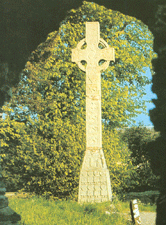Irish Golden Age: High Crosses

Irish history, High Crosses, Ireland, Tall Crosses
 The principal resources for dating events in medieval Irish history are the Annals that provide a continuous year-by-year cryptic summary of Irish political and ecclesiastical events from c.313 to A.D 1590. In the 1630s a group of four Franciscans compiled many of these texts into one enormous compendium, now known as the Annals of the Four Masters. While they sometimes modified the chronology and content of some of these records, they saved for posterity material that would otherwise have been lost.
The principal resources for dating events in medieval Irish history are the Annals that provide a continuous year-by-year cryptic summary of Irish political and ecclesiastical events from c.313 to A.D 1590. In the 1630s a group of four Franciscans compiled many of these texts into one enormous compendium, now known as the Annals of the Four Masters. While they sometimes modified the chronology and content of some of these records, they saved for posterity material that would otherwise have been lost.
High Crosses
Their epithet ‘high’ comes from the Annals of annual records of ecclesiastical and political events accumulated in monasteries from the middle of the sixth to the end of the sixteenth century.
There are about two hundred High Crosses known in Ireland. Though found also in Britain, they are one of Ireland’s most monumental contributions to the art of medieval Europe and the most extensive corpus of stone during the Carolingian era (790-987). The earlier and most numerous ones flourished in the ninth and tenth centuries.
Known as Tall Cross, the ninth century Cross at Monasterboice, Co. Louth, is the tallest in Ireland and displays the largest number of panels of figure sculpture on any High Cross. In sandstone, it stands over 7 metres in height at a monastery site founded by St. Buithe (died 521).
Set in ecclesiastical settlements High Crosses occupied a central position or marked the boundaries of sacred places. Inscriptions at the base of some of the crosses have recently been deciphered showing that they were commissioned by Ireland’s High Kings, demonstrating co-operation between political and church authorities at the time.
Carved from one or more blocks of stone, the crosses are noted for the ring that encircles the arms and upper shaft. The ring would originally have served to support the arms of the cross. The majority can be dated by means of their style and occasionally by inscriptions to the ninth and tenth centuries A.D.
From animal and other symbolism that dominates the earliest pillars the medieval art portrays regional variations. Depicting bible scenes from the Old and New Testaments, different on each cross, they were intended to indicate scriptural stories for the faithful and to induce piety among them.
In this they are Ireland’s answer to the frescoes of Continental and particularly Roman churches, which they emulate in function and composition. The wealth of decoration on the crosses attested to the political and economic importance of some ecclesiastical communities during the Irish Golden Age.

National Museum of Ireland
In the late nineteenth and early twentieth centuries a growing awareness of national identity led to an increased interest in archaeology. In Ireland the wealth of the Irish Golden Age was becoming more and more apparent.
Through Industrial Exhibitions and World Fairs and the international exchange of reproductions of archaeological objects, museums succeeded not only in educating their domestic audiences but broadcasting the wealth of their respective nation’s archaeological heritage. Of all the Irish reproductions manufactured at this time, the most impressive are the plaster casts of the Irish High Crosses, copies of which were exhibited in England, America and Australia.
The casts of the High Crosses commissioned by Col. Plunkett were prominently displayed in the centre Court of the National Museum of Ireland for much of the earlier part of the twentieth century. Later they were removed to the entrance hall of the museum, before finally being placed in storage n the late 1970s to make way for other visitor services.
In recent years the National Museum of Ireland, continuing a tradition of exhibiting reproductions as tools of education, sent a selection of High Cross casts to Nagoya, Japan. Once more the exemplary artistry of Early Christian Irish monasteries was educating peoples, although now through the medium of one-hundred year old plaster.
Golden Age of Early Irish Art
From 1898-1908 Col. G.T. Plunkett, Director of the then Dublin Museum of Science and Art commissioned the reproduction of a number of Irish artefacts. A select number of High Crosses were chosen for the exemplary sculpture and stylised motifs they exhibited.
An Exhibition of the High Cross Replicas and other Irish Early Christian Treasures is taking place in 2007 at Collins Barracks. It brings together six plaster casts of High Crosses with their unique styles featuring religious and contemporary figures and sculpture from a period that is looked upon as the Golden Age of Early Irish Art.
 Ita Marguet, October 2007
Ita Marguet, October 2007
Note: Acknowledgement is given to all sources of information used in preparation of this text including the Exhibition guide of the National Museum of Ireland.


